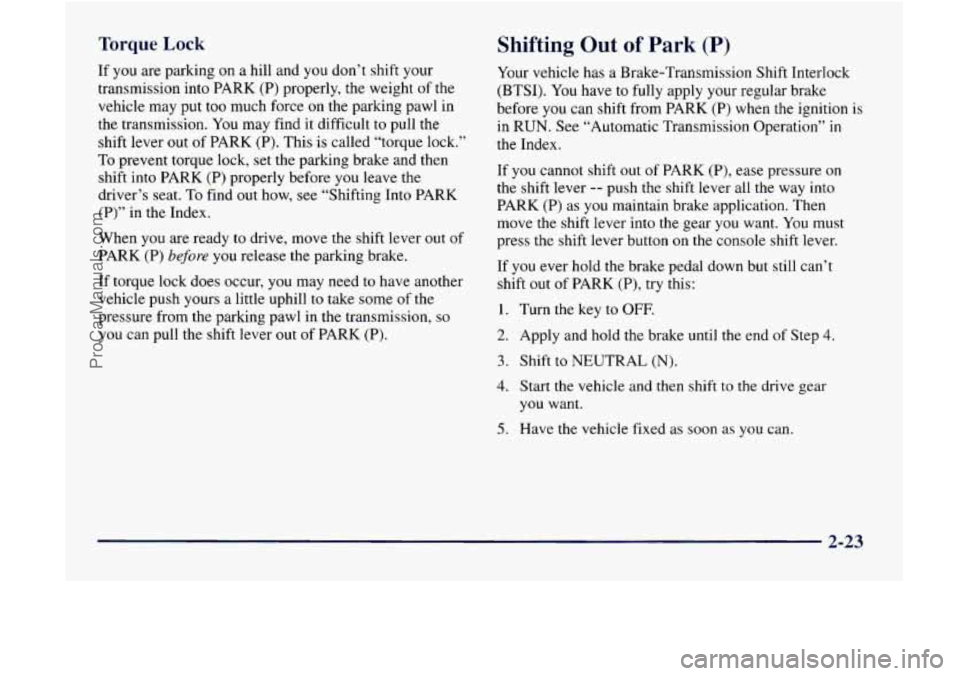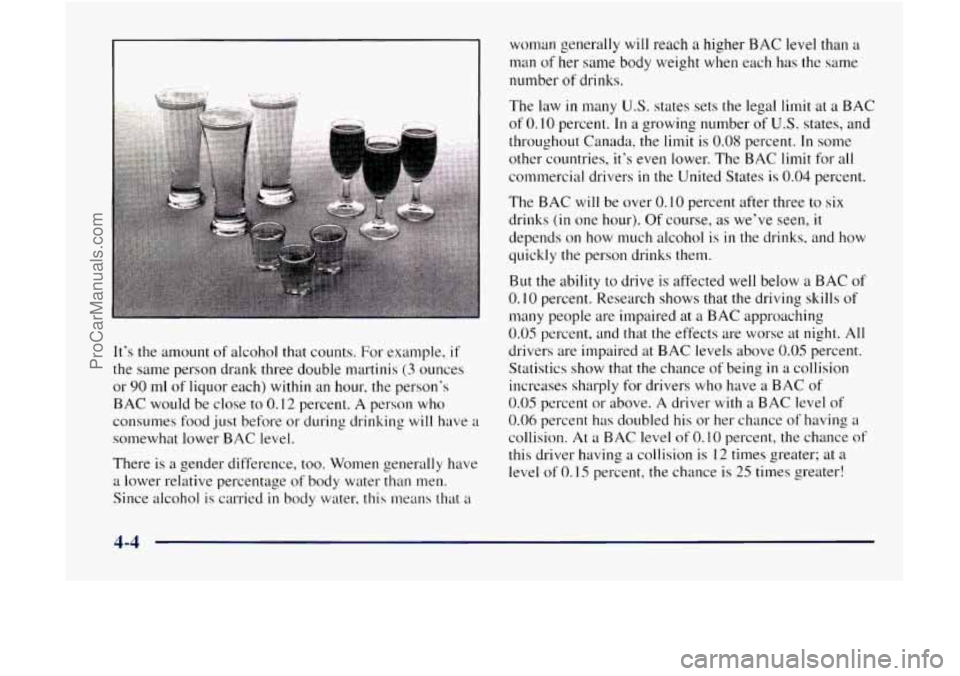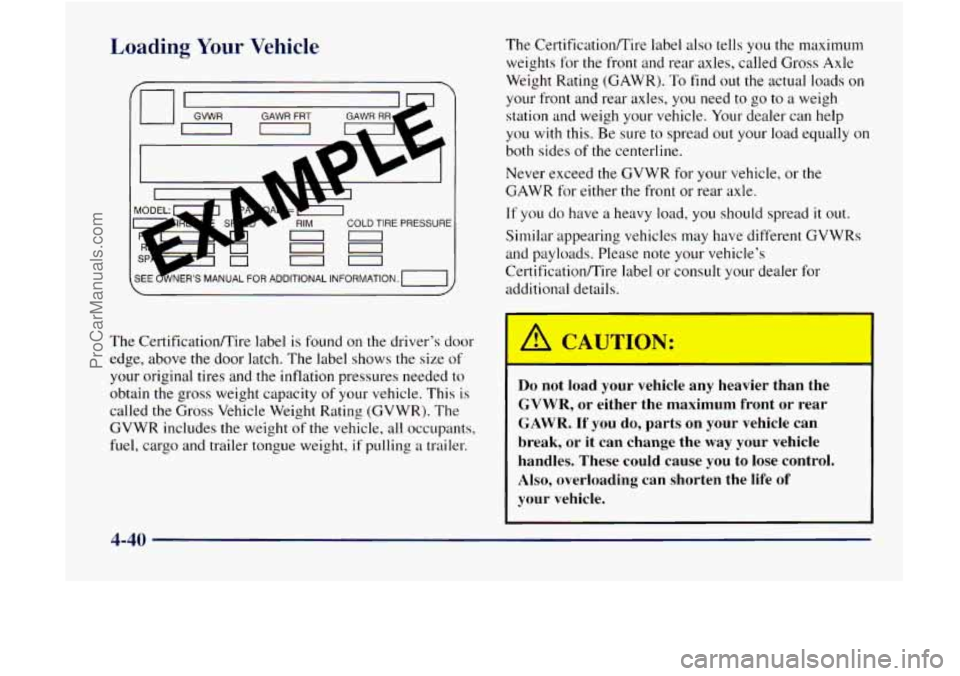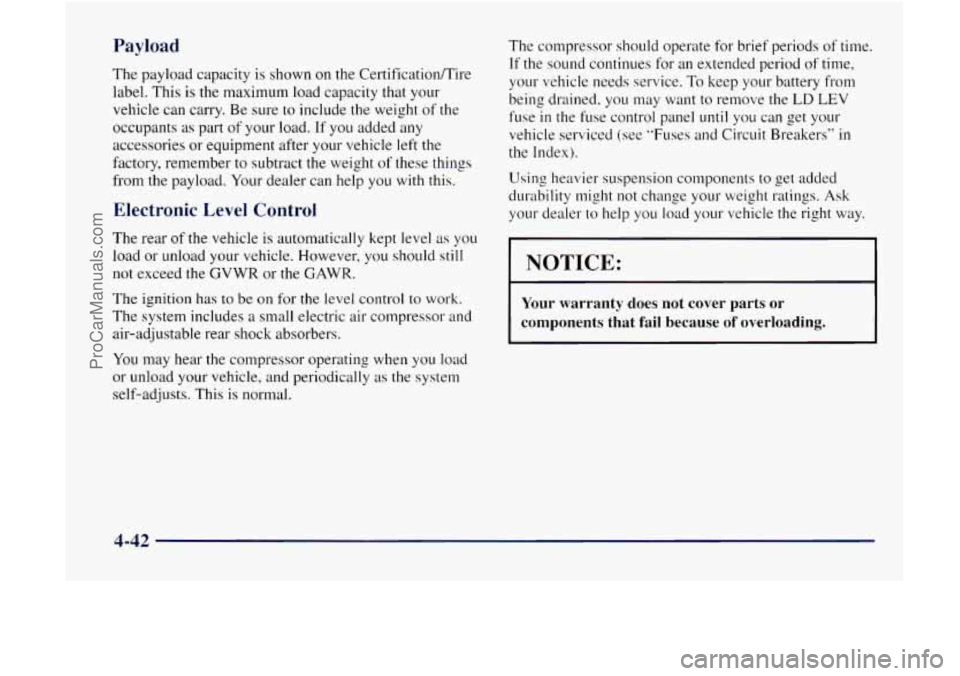weight GMC ENVOY 1998 Owners Manual
[x] Cancel search | Manufacturer: GMC, Model Year: 1998, Model line: ENVOY, Model: GMC ENVOY 1998Pages: 386, PDF Size: 20.33 MB
Page 45 of 386

Child Restraints
Every time infants and young children ride in vehicles,
they should have protection provided by
appropriate restraints.
@ What are the different types of add-on
A: Add-on child restraints are available in four basic
types. When selecting
a child restraint, take into
consideration not only the child’s weight and size,
but
also whether or not the restraint will be
compatible with the motor vehicle
in which it
will be used.
child restraints?
An infant car bed (A) is a special bed made for use
in a motor vehicle. It’s an infant restraint system
designed to restrain or position a child on a
continuous flat surface. With an infant car bed,
make sure that the infant’s head rests toward
the
center of the vehicle.
1-38
ProCarManuals.com
Page 84 of 386

Torque Lock Shifting Out of Park (P)
If you are parking on a hill and you don’t shift your
transmission into PARK (P) properly, the weight
of the
vehicle may put too much force on the parking pawl in
the transmission. You may find it difficult to pull the
shift lever out
of PARK (P). This is called “torque lock.”
To prevent torque lock, set the parking brake and then
shift into PARK (P) properly before you leave the
driver’s seat.
To find out how, see “Shifting Into PARK
(P)” in the Index.
When you are ready to drive, move the shift lever
out of
PARK (P)
before you release the parking brake.
If torque lock does occur, you may need to have another
vehicle push yours a little uphill
to take some of the
pressure from the parking pawl in
the transmission, so
you can pull the shift lever out of PARK (P). Your
vehicle has
a Brake-Transmission Shift Interlock
(BTSI). You have to fully apply your regular brake
before you
can shift from PARK (P) when the ignition is
in RUN. See “Automatic Transmission Operation”
in
the Index.
If you cannot shift out of PARK (P), ease pressure on
the shift lever
-- push the shift lever all the way into
PARK
(P) as you maintain brake application. Then
move
the shift lever into the gear you want. You must
press the shift lever button on the console shift lever.
If
you ever hold the brake pedal down but still can’t
shift out
of PARK (P), try this:
1. Turn the key to OFF.
2. Apply and hold the brake until the end of Step 4.
3. Shift to NEUTRAL (N).
4. Start the vehicle and then shift to the drive gear
you want.
5. Have the vehicle fixed as soon as you can.
2-23
ProCarManuals.com
Page 110 of 386

NOTICE:
Loading cargo that weighs more than 200 Ibs.
(91 kg) on the luggage carrier may damage your
vehicle. When you carry large things, never let
them hang over the rear or the sides of your
vehicle. When loading cargo on the roof panel, be
sure it rests on the slats and does not scratch or
damage the vehicle.
Put the cargo against the side rails and fasten it
securely to the luggage carrier. Put the main
weight as
far forward as you can and move the
rear crossrail forward as
far as possible to keep
the load from shifting.
Don’t exceed the maximum vehicle capacity when
loading your vehicle. For more information on vehicle
capacity and loading, see “Loading Your Vehicle“
in
the Index.
To prevent damage or loss of cargo as you’re driving,
check now and then to make sure the luggage carrier and
cargo are still securely fastened.
Ashtrays and Cigarette Lighter
The ashtray is located in the center floor console, in
front
of the shift lever. Flip the cover to expose
the ashtray.
NOTICE:
Don’t put papers and other things that burn into
your ashtray.
If you do, cigarettes or other
smoking materials could set them on fire
causing damage.
To remove the front ashtray, pull the bin upward.
The lighter is located
in the instrument panel below the
climate controls.
To use the lighter, press it in all the
way, and let
go. When it’s ready, it will pop back
by itself.
2-49
I
ProCarManuals.com
Page 162 of 386

Drunken Driving
Death and injury associated with drinking and driving is
a national tragedy. It’s the number one contributor to
the
highway death toll, claiming thousands of victims
every year.
Alcohol affects four things that anyone nee.ds
to drive
a vehicle:
0 Judgment
0 Muscular Coordination
Vision
0 Attentiveness.
Police records show that almost half of all motor
vehicle-related deaths involve alcohol. In most cases,
these deaths are
the result of someone who was drinking
and driving. In recent years, over
17,000 annual motor
vehicle-related deaths have been associated with the use
of alcohol, with more than
300,000 people injured.
Many adults
-- by some estimates, nearly half the adult
population
-- choose never to drink alcohol, so they
never drive after drinking. For persons under 2
1, it’s
against the law
in every U.S. state to drink alcohol.
There are good medical, psychological and
developmental reasons for these laws. The obvious
way to solve this highway safety problem
is for people never
to drink alcohol and then drive. But
what
if people do? How much is ”too much” if the
driver plans to drive? It’s
a lot less than many might
think. Although
it depends on each person and situation,
here
is some general information on the problem.
The Blood Alcohol Concentration
(BAC) of someone
who is drinking depends upon four things:
0 The amount of alcohol consumed
0 The drinker’s body weight
The amount of food that is consumed before and
during drinking
0 The length of time it has taken the drinker to
consume the alcohol.
According to the American Medical Association,
a
180-lb. (82 kg) person who drinks three 12-ounce
(355 ml) bottles of beet- in an hour will end up with a
BAC of about 0.06 percent. The person would reach the
same
BAC by drinking three 4-ounce (120 ml) glasses
of wine or three mixed drinks
if each had 1 - 1/2 ounces
(45
mlj of a liquor like whiskey, gin or vodka.
4-3
ProCarManuals.com
Page 163 of 386

It's the amount of alcohol that counts. For example, if
the same person drank three double martinis (3 ounces
or
90 ml of liquor each) within an hour, the person's
BAC would be close to 0.12 percent.
A person who
consumes food just before or during drinking will have a
somewhat lower BAC level.
There is a gender difference,
too. Women generally have
a lower relative percentage of body water than men.
Since alcohol is carried
in body water. this ~neans that a
woman generally will reach a higher BAC level than a
miin of her same body weight when each has the same
number
of drinks.
The law
in many US. states sets the legal limit at a BAC
of 0.10 percent. In a growing number of U.S. states, and
throughout Canada, the limit is 0.08 percent.
In some
other countries, it's even lower. The BAC
limit for all
commercial drivers
in the United States is 0.04 percent.
The BAC
will be over 0.10 percent after three to six
drinks
(in one hour). Of course, as we've seen, it
depends on how much alcohol is in the drinks, and how
quickly the person drinks them.
But the ability to drive is affected well below a BAC of
0.10 percent. Research shows that the driving skills of
many people are impaired at a BAC approaching
0.05 percent, and that the effects are worse at night. All
drivers are impaired at BAC levels above 0.05 percent.
Statistics show that the chance
of being in a collision
increases sharply for drivers who have a
BAC of
0.05 percent
or above. A driver with a BAC level of
0.06 percent has doubled
his or her chance of having a
collision.
At a BAC level of 0.10 percent, the chance of
this driver having a collision is
12 times greater; at a
level of 0. IS percent, the chance is 25 times greater!
4-4
ProCarManuals.com
Page 166 of 386

And, of course, actual stopping distances vary greatly
with the surface of the road (whether it‘s pavement or
gravel);
the condition of the road (wet, dry, icy); tire
tread; the condition of your brakes; the weight of the
vehicle and the amount of brake force applied.
Avoid needless heavy braking. Some people drive
in
spurts -- heavy acceleration followed by heavy
braking
-- rather than keeping pace with traffic. This is a
mistake. Your brakes may not have time to cool between
hard stops. Your brakes will wear out rnucit faster
if you
do a lot of heavy braking.
If you keep pace with the
traffic and allow realistic following distances, you
will
eliminate a lot of unnecessary braking. Th, ti t means
better braking and longer brake life.
If your engine ever stops while you’re driving, brake
normally but don’t pump your brakes.
If you do, the
pedal may get harder
to push down. If your engine
stops,
you will still have some power brake assist. But
you will use it when you brake. Once the power assist is
used
up, it may take longer to stop and the brake pedal
will be harder
to push.
Anti-Lock Brakes (ABS)
Your vehicle has anti-lock brakes (ABS). ABS is an
advanced electronic braking system that will help
prevent
;1 braking skid.
When you start your engine and begin to drive away,
your anti-lock brake system
will check itself. You may
hear
a momentary motor or clicking noise while this test
is going on. This is normal.
If there’s a problem with the
anti-lock brake system, this
warning light
will stay on.
See “Anti-Lock Brake
System Warning Light”
in
the Index.
4-7
1
ProCarManuals.com
Page 182 of 386

Q.' Am I likely to stall when going downhill?
A: It's much nm-e likely to happen going uphill. But if
it happens going downhill, here's what to do.
0 Stop your vehicle by applying the regular brakes.
Shift to PARK (P) and. while still braking. restart
Apply the parking
brake.
the engine.
Shift back to a low gear, release the parking brake,
and drive straight d6wn.
0 If the engine won't start, get out and get
Driving Across an Incline
Sooner or later, an off-road trail will probab lelp. y go
across
the incline
of a hill. If this happens, you have to decide
whether to
try to dri\:e across the incline. Here are some
things to consider:
0 A hill that can be driven straight up or down may be
too steep to drive across. When you
go straight up or
down a
hill, the length of the wheel base (the
distance from the front wheels
to the rear wheels)
reduces the likelihood the vehicle
will tumble end
0
0
over end. But when you drive across an incline, the
much more narrow track width
(the distance between
the left and right wheels) may not prevent the vehicle
from tilting and rolling over.
Also. driving across an
incline puts more weight on the downhill wheels.
This could cause a downhill slide
or a rollover.
Surface conditions can be
a problem when you drive
across
a hill. Loose gravel, muddy spots, or even wet
If the vehicle slips sideways, it can hit something
that
will trip it (a rock, a rut, etc.) and roll over.
Hidden obstacles can make the steepness
of the
incline even worse.
If you drive across a rock with
the
uphill wheels. or if the downhill wheels drop into
a rut or depression, your vehicle can tilt even n1oI-e.
e orass can cause your tires to slip sideways. downhill.
For reasons like these.
you need to decide carefully
whether to
try to drive across an incline. Just because
the trail goes across the incline doesn't mean you have
to drive it. The last vehicle to try it might have
rolled over.
4-23
I
ProCarManuals.com
Page 199 of 386

Loading Your Vehicle
The CertificatiodTire label is found on the driver’s door
edge, above the door latch. The label shows the size of
your original tires and the inflation pressures needed to
obtain the gross weight capacity
of your vehicle. This is
called the Gross Vehicle Weight Rating (GVWR). The
GVWR includes the weight of
the vehicle, all occupants,
fuel, cargo and trailer tongue weight, if pulling a trailer. The
Certification/Tire label
also tells you the maximum
weights for the front and rear axles, called
Gross Axle
Weight Rating (GAWR).
To find out the actual loads on
your front and rear axles, you need to go to a weigh
station and weigh your vehicle. Your dealer can help
you with this. Be sure to spread out your load equally on
both sides of the centerline.
Never exceed the GVWR for your vehicle,
or the
GAWR for either the
front or rear axle.
If you do have a heavy load, you should spread it out.
Similar appearing vehicles may have different GVWRs
and payloads. Please note your vehicle’s
Certificatian/Tire label or consult your dealer for
additional details.
I
A (- %I---- - -,
Do not load your vehicle any heavier than the
GVWR, or either the maximum front or rear
GAWR. If you do, parts on your vehicle can
break,
or it can change the way your vehicle
handles. These could cause you to lose control. Also, overloading can shorten the life of
your vehicle.
4-40
ProCarManuals.com
Page 200 of 386

Using heavier suspension components to get added
durability might not change your weight ratings. Ask
your dealer to help you load your vehicle the right way.
-
NOTICE:
Your warranty does not cover parts or
components that fail because of overloading.
If you put things inside your vehicle -- like suitcases,
tools, packages, or anything else
-- they will go as fast
as the vehicle goes. If you have to stop or turn quickly,
or if there is a crash, they’ll keep going.
A CAUmmdN:
Things you put inside your vehicle can strike and
injure people in a sudden stop or turn, or in
a crash.
0 Put things in the cargo area of your vehicle.
0 Never stack heavier things, like suitcases,
Try to spread the weight evenly.
inside the vehicle
so that some of them are
above the tops of the seats.
0 Don’t leave an unsecured child restraint in
your vehicle.
0 When you carry something inside the
vehicle, secure
it whenever you can.
0 Don’t leave a seat folded down unless you
need to.
There’s also important loading information for off-road
driving in this manual. See “Loading Your Vehicle for
Off-Road Driving” in the Index.
4-41
ProCarManuals.com
Page 201 of 386

Payload
The payload capacity is shown on the CertificationRire
label. This is the maximum load capacity that your
vehicle can carry. Be sure to include the weight of the
occupants as part
of your load. If you added any
accessories or equipment after your vehicle left the
factory, remember to subtract the weight
of these things
from the payload.
Your dealer can help you with this.
Electronic Level Control
The rear of the vehicle is automatically kept level as you
load
or unload your vehicle. However, you should still
not exceed the
GVWR or the GAWR.
The ignition has to be on for the level control to work.
The system includes a small electric air compressor and
air-adjustable rear shock absorbers.
You may hear the compressor operating when you load
or unload your vehicle, and periodically
as the system
self-adjusts. This is normal. The compressor should operate for
brief periods
of time
If the sound continues for an extended period of time,
your vehicle needs service.
To keep your battery from
being drained. you may want to remove the
LD LEV
fuse in the fuse control panel until you can get your
vehicle serviced (see “Fuses and Circuit Breakers”
in
the Index).
Using heavier suspension components to get added
durability might not change your weight ratings.
Ask
your dealer to help you load your vehicle the right way.
NOTICE:
Your warranty does not cover parts or
components that fail because
of overloading.
ProCarManuals.com